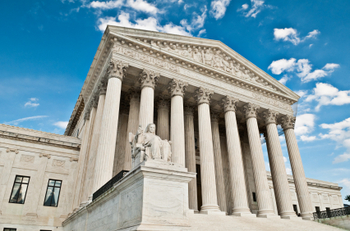
Cass Sunstein analyzes recent ruling through the lenses of originalism and Burkeanism.
In January, a court decision that declared unconstitutional an administrative appointment made by President Obama catapulted the National Labor Relations Board (NLRB)—one of the lesser-known independent governmental agencies—from obscurity to front-page news.
At that time, the U.S. Court of Appeals for the District of Columbia Circuit ruled that the Recess Appointments clause in the U.S. Constitution only allows the president to make appointments without Senate confirmation in between the annual congressional sessions (intersession)—not during a break that Congress takes within a single year (intrasession). The court also ruled that the President’s use of the recess appointments power is limited to filling vacancies that actually arise during the intersession period. As a consequence, the court held unconstitutional President Obama’s intrasession appointment of three commissioners to serve on the NLRB.
This decision in Canning v. NLRB certainly made headlines, particularly for its departure from Presidents’ historical practice of using recess appointments during intrasession breaks. However, as Cass Sunstein has noted in a recent paper, “Originalism v. Burkeanism: A Dialogue Over Recess,” the Canning case may reveal as much about opposing theories of constitutional interpretation as about the recess appointments clause.
Although there are many different theories of constitutional interpretation, Sunstein focuses on two that appear to lie on opposite ends of a spectrum: originalism and Burkeanism. Unlike originalists, who “believe that the Constitution means what it originally meant,” Sunstein says that Burkeans “believe that longstanding practices and understandings deserve a high degree of deference,” even if they depart from original meaning. However, as Sunstein’s article demonstrates, these seemingly conflicting constitutional theories actually share common underlying motivations.
In Canning, the D.C. Circuit Court relied on an originalist interpretation when it declared that the previously uncontested practice of intrasession appointments violated the Constitution. The court read the Recess Clause strictly, noting that it grants the president the right to make appointments during “the” recess of the Senate. Relying on this grammatical construction and the Constitution’s apparent use of the term “adjournment” without the word “the” in reference to other congressional breaks, the Court reached the “inescapable conclusion that the Framers intended something specific by the term ‘the Recess,’ [other] than a generic break in proceedings.”
To highlight some of the main differences between originalism and Burkeanism, Sunstein creatively structures his analysis as a dialogue between adherents to these two theories.
The Burkean begins by noting that a strict adherence to an originalist Constitutional interpretation would suggest that racial segregation, certain forms of gender discrimination, and other similar outdated government policies should be upheld simply due to the fact that they were considered constitutional at the time of the framers.
However, the originalist notes that support for originalism stems from the belief that it “limits judicial discretion, promotes the rule of law, increases stability, reduces the risk of rule by unelected judges, and traces constitutional judgments directly to the views of We the People.”
With that said, Sunstein’s originalist, who refers to himself as an originalist “for reasons”, notes that his belief permits some exceptions to a strict constitutional reading, particularly if a different constitutional interpretation is more likely to advance the same underlying goals that originalism seeks to accomplish. These exceptions specifically apply in situations where “(1) judicial precedents are well-entrenched and longstanding and (2) insistence on the original understanding would be highly disruptive to established practices and understandings.”
Sunstein’s dialogue not only highlights the general differences between the two theories of constitutional interpretation but also provides a specific discussion of the Canning case through the lens of these theories.
According to Sunstein, the Burkean takes issue with the Court’s reasoning that the founders used the word “the” to denote “the one and only” recess, and notes that, since intrasession recesses did not exist until after the Civil War, any judicial attempt to determine framers’ intentions would lead to unclear results, at best. Given this ambiguity, the Burkean argues that the court’s willingness “to adopt a contested understanding of the text to override very longstanding understandings on the part of the President and the Senate alike” was “extraordinary.”
However, what the Burkean sees as political tradition, the originalist characterizes, in Sunstein’s account, as “self-serving accommodations by Congress and the President” which should not override longstanding judicial interpretations, particularly since those practices served the interests of officials and not the people.
The Burkean, says Sunstein, would challenge the originalist’s argument on two grounds: first, “by virtue of their longevity, [longstanding practices] are likely to be sensible and wise”; and second, rejecting longstanding practices could be highly disruptive and “may cause all sorts of ripple effects, which are likely to include unintended bad consequences and high costs.”
In the end, the originalist and the Burkean appear to agree that courts should avoid overruling longstanding practices if they will result in instability and be highly disruptive to society. Sunstein’s creative article sheds light on the tensions between varying constitutional interpretations revealing that, although they may differ widely in substance, they might also be quite similar in their underlying goals and motivations.
The Supreme Court granted certiorari on June 24, 2013 and the Court will review the D.C. Circuit decision this term.



